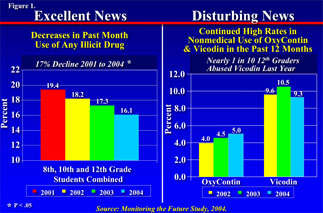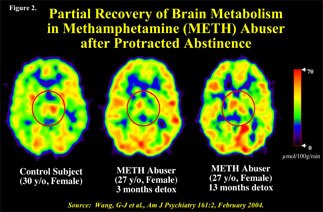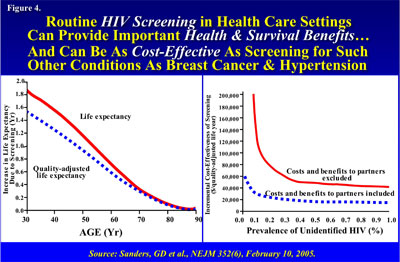Statement for the Record
Mr. Chairman and Members of the Committee:
I am pleased to present the Fiscal Year (FY) 2006 President's budget request for the National Institute on Drug Abuse (NIDA). The FY 2006 budget includes $1,010,130,000 an increase of $3,711,000 over the FY 2005 enacted level of $1,006,419,000 comparable for transfers proposed in the President's request.
Meeting Public Health Needs and Taking Advantage of Scientific Opportunities
In this age of unprecedented scientific opportunity, NIDA is poised to strike the delicate balance between taking advantage of new opportunities, supporting strong science, and meeting existing and emerging public health needs. Since I became Director in May 2003, we have called upon internal and external experts and our National Advisory Council to systematically evaluate about 80% of our portfolio. This important exercise has allowed us to strategically set our research priorities. Today, I would like to highlight some significant new outcomes from our portfolio and discuss NIDA's plans to optimize the impact that science will have on the health of the public.
Adolescent Brain Development and Drug Prevention
As the world's largest supporter of research on the health aspects of drug abuse and addiction, NIDA has made tremendous progress in understanding addiction as a chronic, relapsing disease, which affects both brain and behavior. We also now know that addiction is a developmental disorder that begins in adolescence, and sometimes as early as childhood. Recent advances have provided us with more insight into why teens engage in risk-taking and thrill-seeking behaviors. These behaviors are likely due to the fact that the part of the brain responsible for judgment, decision-making, and control of emotional responses, the prefrontal cortex, is the last area of the brain to mature. Understanding the impact that drugs can have on normal brain development, risk perception, and vulnerability to future drug use, will allow us to maximize prevention and early intervention strategies with youth. We will also rely on basic research with animals to directly examine the effects that early exposure to drugs can have on brain development and behavior. Nicotine, for example, when given to young animals can increase the effects of the drug in adulthood. NIDA will continue to use science to increase our ability to dissuade teens from abusing drugs by focusing on cognitive processes (learning, judgment, and decision-making) and emotional processes (social reinforcers, motivation, and stress responses). From both experience and from research, we know that prevention and early intervention are critical to healthy development. For these reasons, NIDA is pleased to be a participant in the NIH MRI Study of Normal Brain Development, which will help discern more about normal brain development and the effects that drugs can have on it.
Environmental Factors: The Role of Early Experience
Research shows that both genetic and environmental factors impact how an individual develops. Good parenting skills, for example, can have a significant impact on a child's mental and physical health, since behaviors are often molded by early experiences. We know this from animal studies as well, where researchers have shown that early maternal behaviors can affect neurobiological development and shape the way an animal responds to stress throughout its life. We also know that ineffective parenting can increase a child's risk for a range of maladaptive behaviors. NIDA-supported researchers found that many of the risk-taking behaviors of adult women who contract HIV were associated with childhood sexual abuse, suggesting that early learned behaviors, negative or positive, could impact later disease outcomes. Early exposure to stress or trauma is also known to be a risk factor for both substance abuse and mental health disorders. For this reason, it is critical that we devote resources to develop interventions that are geared towards children and adolescents who may be at high risk for co-morbidity. Educating pediatricians and primary care physicians about this issue and working toward the development of a more integrated health care system to address the reality of co-occurring diseases are important first steps.
Drug Use Rates: The Good, The Bad, And The Need To Do More To Combat Emerging Problems Such As Methamphetamine
When NIDA released its 2004 Monitoring the Future data in late December we were encouraged by much of the news about declines in drug use (See Figure 1).

Eighth, tenth, and twelfth grade students showed a continuing downward trend in drug use, with almost a 7 % decline from 2003 to 2004 and about a 17% decline over the last three years. However, a few troublesome problems revealed themselves. We found that there is a "silent epidemic" lurking, one that strikes young children. It is the use of inhalants. For the second year in a row, we are seeing eighth graders abusing inhalants at disturbing rates, with nearly one in five reporting that they had tried inhalants. In response, NIDA launched a new website in January, www.inhalants.drugabuse.gov, and formed partnerships with other stakeholders including the Community Anti-Drug Coalitions of America and the National Inhalant Prevention Coalition to create awareness among parents, teachers, students, and community leaders about the potential dangers that common household products used as inhalants can bring in their wake.
The MTF and other monitoring mechanisms have also alerted us to some disturbing news about the abuse of prescription drugs. When used as prescribed, these medications are very effective, but non-medical use of medications like opioids, central nervous system depressants, and stimulants can lead to abuse and addiction. About 5% of 12th graders reported using Oxycontin for non-medical purposes, and about 9.3% of 12th graders, or nearly one in 10, reported similar use of Vicodin in the past year, making Vicodin one of the most commonly abused drugs in this population. Similarly about 10% of 12th graders reported non-medical use of amphetamines in the past year, a class of stimulant drugs often prescribed to treat Attention Deficit Hyperactivity Disorder (ADHD). NIDA has reinvigorated its research and dissemination efforts on prescription drug abuse, especially in the treatment area. We will launch later this year two large-scale clinical studies in our Clinical Trials Network. One will focus on treatments for prescription opiate abuse and the other on treatments for substance abusers who also suffer from ADHD.
NIDA also continues to monitor methamphetamine use in the country. Though we are seeing significant decreases in methamphetamine use among eighth graders, the use among 10th and 12th graders appear to have stabilized according to MTF. Moreover, NIDA's Community Epidemiology Work Group (CEWG), which monitors drug abuse problems in sentinel areas across the Nation, is alerting us to increases in 11 of the 21 CEWG areas, including rural areas. Methamphetamine also appears to be growing in popularity among men who have sex with men, and is often associated with risky sexual behaviors, which can increase the risk for transmission of HIV, hepatitis C, and other STDs. Indeed, the recent case of an HIV-infected methamphetamine abuser with a particularly virulent strain of HIV has raised concern over the potential deleterious effects of mehtamphetamine on the immune system and medication response. To curtail the spread of methamphetamine and its related consequences, NIDA maintains a comprehensive program that includes basic, epidemiological, prevention and treatment research.

NIDA focuses much effort on finding treatments for methamphetamine abuse and addiction. Currently cognitive behavioral interventions remain the most effective way to treat methamphetamine abuse, though we are making progress in developing medications through the five sites that comprise our Methamphetamine Clinical Trials Group (MCTG). Additionally, NIDA is very concerned about the effects of methamphetamine on the development of children exposed to the drug prenatally. NIDA recently launched the first large-scale study of the developmental consequences of methamphetamine exposure, which includes seven hospitals in Iowa, Oklahoma, California and Hawaii. At a more basic level, we are learning more about the long and short-term effects of this addictive stimulant, including how it affects brain structure and function. As you can see in the brain images depicted in Figure 2 (above), after about a year of abstinence from methamphetamine, there appears to be recovery in some parts of the brain. Brain activity or metabolism in the thalamus, an important area for coordinating the response of the brain to external stimuli, returned to near normal levels. The images in Figure 3 (below) also illustrate that some of the destructive effects of methamphetamine may be reversible, as seen by the recovery of dopamine transporters after prolonged abstinence. More research needs to be supported to understand the impact these changes have on brain function and to determine why other parts of the brain do not recover.

Translating Research to Improve Health of the Nation
NIDA has made much progress in developing effective treatments for addiction, both behavioral and pharmacological. In addition to bringing new medications like buprenorphine and buprenorphine/naloxone to physicians treating opiate dependence, NIDA's medications program is bringing us one step closer to having new treatments for cocaine addiction. It has identified several promising compounds in animal studies and has shown initial efficacy in clinical studies of several marketed medications (such as disulfiram for alcoholism, modafinal used to treat narcolepsy; and topiramate for seizures). Progress is also being made to develop vaccines for cocaine and nicotine addiction, as well as new treatments for marijuana abuse and addiction.
Testing treatments in real life settings is a top priority for NIDA. Six different treatment protocols have been completed in our national clinical trials infrastructure, including a medication detoxification protocol that has shown to be acceptable to both patients and providers, and is being adopted in traditional "medication or drug-free" clinics. We are also proud of the fact that through our collaborations with the Substance Abuse and Mental Health Services Administration (SAMHSA) we were able to develop two research dissemination products that treatment providers and managers can use to improve the quality of treatment in their communities. Three other products derived from CTN research findings are currently being developed by the NIDA and SAMHSA "blending teams." NIDA is also working with SAMHSA to stimulate and support innovative research to determine the components necessary for adopting, adapting, delivering, and maintaining effective evidence-based programs, and practices.
Reducing HIV/AIDS Rates

NIDA-supported researchers continue to look for cost effective ways to prevent and treat diseases. Just last month, two independent papers published in the New England Journal of Medicine reinforced the value of screening interventions for HIV and provided food for thought for changing the current recommendations on screening in populations with lower HIV prevalence rates. Using modeling paradigms, the researchers showed that if you screen for HIV in health care settings, detect it, and start active antiretroviral therapy (HAART) early you can increase life expectancy and reduce transmission rates, comparable to what is seen with screening for breast cancer and high blood pressure (see Figure 4). For example, a person who is screened at 30 years of age, would increase life expectancy by almost two years. Moreover the researchers also estimated that by expanding screening to a larger segment of the population HIV transmission rates can be decreased by about 20%. Screening can improve the quality of life of individuals and appears to be cost-effective for society.
NIDA is also pursuing ways to reduce the burden of HIV and other medical consequences often associated with drug abuse among all populations, but is particularly interested in reducing HIV rates among African Americans. The HIV/AIDS epidemic has taken a disproportionate toll on racial and ethnic minority populations. The CDC reports that during 2000-2003, HIV/AIDS rates for African American males were 7 times those for white males, and African American females were 19 times the rates for white females and exceeded the rates for males of all races/ethnicities other than African Americans. NIDA has launched an initiative that is specifically focusing on reducing HIV rates among African Americans, including conducting more studies in geographic areas where rates are highest and developing interventions that are ethnically appropriate. Identifying other avenues for intervention, such as correctional facilities to prevent HIV in this population is also another priority for NIDA. African American males are nearly 8 times more likely to be incarcerated than white males, and much of this is for drug-related crimes. Supporting research on the intersection of drug use and criminal justice consequences in the African American population will help us develop improved prevention and treatment services.
Accelerating Neuroscience Research Through NIH Neuroscience Blue Print and Road Map Activities
Recognizing that neuroscience research is the foundation for all of our drug abuse prevention and treatment efforts, NIDA will look for innovative and cost-effective ways to support this critical research. For example, NIDA is an active participant in the new NIH Neuroscience Blueprint activities. The Blueprint provides a forum for the 15 NIH Institutes and Centers that support research on the nervous system to pool resources and expertise. In addition to taking the lead in inventorying all the neuroscience tools funded by NIH and government agencies this year, in FY 2006 NIDA will take the lead in developing crosscutting training mechanisms for important areas such as neuroimaging and computational biology. NIDA researchers are also benefiting from their participation in NIH Roadmap activities, especially the Molecular Libraries and Imaging efforts.
Conclusion
NIDA's research portfolio is comprehensive and strategically poised to take advantage of new opportunities that present themselves. We continue to make great strides to translate and disseminate research-based products so they can be used in the real world, providing the Nation with the tools necessary to reduce drug use in this country. Sustaining the momentum of our efforts will lead to even more discoveries that will improve health for all Americans.
Thank you, Mr. Chairman. I will be pleased to answer any questions the Committee may have.
